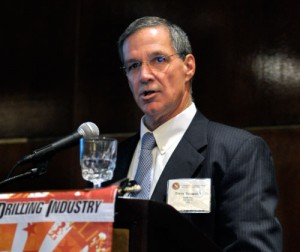For Anadarko in Marcellus, environmental performance is top priority

Anadarko Petroleum is ramping up activity in the Marcellus Shale, where it expects to run nine rigs, including two “spudder” rigs, and drill 115 wells by year-end 2011, Steve Bosworth, the company’s vice president of worldwide drilling, said during a presentation at the 2011 IADC Drilling Onshore Conference & Exhibition on 19 May in Houston. A top priority in this region is environmental performance, he emphasized, and the company has taken numerous steps to protect its surroundings and reduce its operational footprint.
“Protecting the land, air and water is something we take really seriously, and we strive to achieve high standards in EHS. Most of the (regulatory) agencies they have up there, I think, are glad that Anadarko’s up there, and we’re proud of that,” Mr Bosworth said.
One example of environmental stewardship is groundwater protection. In its Marcellus wells, Anadarko sets casing at 700 ft, then another string at 2,000 ft, while air-drilling to the kickoff point. The practice initially began as a means to address an operational concern and has now taken hold as a standard – even though some believe the local groundwater could be adequately protected with one string of casing. “Running multiple strings of steel pipe and cementing all the way to surface is the right thing to do for the environment in Pennsylvania, although operationally, it’s not required to maintain formation stability,” he said.
The company also has been able to slim down its wellbore design by switching from water-based mud to synthetic-based mud and eliminating a 7-in. intermediate casing string. This year the company is going to set an 11 ¾-in. string, and then 8 5/8-in., for a 5 ½-in. production scenario. “By slimming it down we actually reduced our cement and our waste volume by 20%,” Mr Bosworth noted.
The slim-hole design also lessens the impact of truck traffic on the local road infrastructure and surrounding communities.
Instead of open-hole packers, Anadarko completes its wells using the plug-and-perforate method, typically 15 to 20 stages per well over approximately 6,000-ft lateral sections. “Like everybody, we’re trying to figure out the best way to complete these wells, continue to test and have the optimal design, working with the hydraulic fracturing companies,” he said.
The need for water is obviously significant – approximately 100,000 barrels per well – and Anadarko does work hard at water reclamation, recycling and re-use. “We recycle and re-use 100 percent of the water we get back from the well, on-site through filtration activities.”
To reduce its footprint – critical because there are state forests and pristine trout stream in the area – pad drilling is used. Six wells are drilled per pad. “It’s a really pretty area and we want to do a good job and get along with the communities,” Mr Bosworth said.
Other environmental initiatives Anadarko is taking include working with contractors to implement the “Eyes On” program, where anytime fluid is being transferred, there’s somebody required to keep their eyes on it, and not walk away to perform another task. In the completion phase, the company also lines the entire location under frac equipment and fluid storage using a static-free, anti-slip and tear-resistant material.
Simultaneous to these environmental initiatives, the operator is also working to increase efficiency and reduce drilling times through things such as better bit designs, high-torque motors and electromagnetic MWD tools. The company also made a conscious decision to switch to high-technology rigs in 2006, and Mr Bosworth believes these advanced drilling units have proven their value. “We do believe big time that our efficiency improvements have been due to types of equipment and people that we’ve contracted,” he said.
The company averaged 30 days for each of the 52 wells drilled in 2010. So far this year, the best well took 13.5 days to drill. “And we’ve got seven in the last 10 in less than 20 (days), so our goal is to safely do it all from spud to rig release in less than 15 days,” he said.




